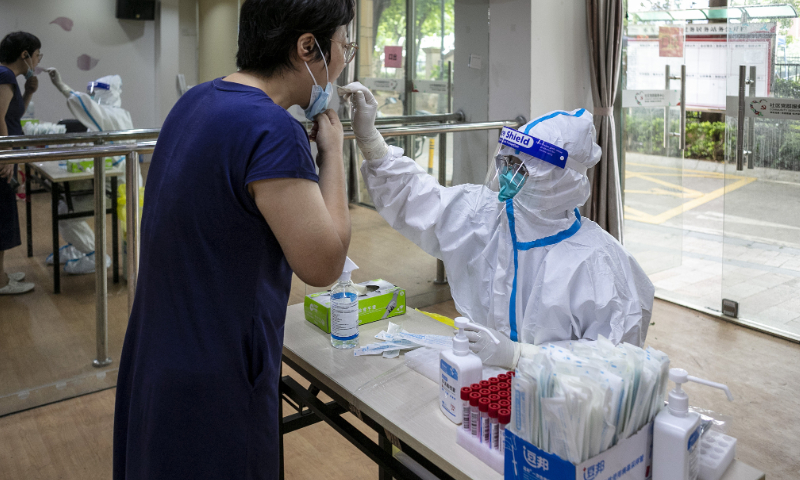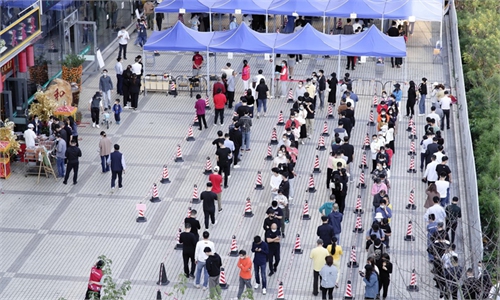
A resident is taking nucleic acid test in Shenzhen on August 30, 2022. Photo: VCG
Chinese tech hub Shenzhen, a city bordering the Hong Kong Special Administrative Region with 17 million residents announced on Wednesday that residents who need to leave the city should present negative nucleic acid test proof twice within 48 hours starting from Thursday as the city has seen a COVID-19 resurgence since August 28 with a new Omicron mutation detected.
Residents are advised not to leave Shenzhen unless it is necessary, and the measures will be adjusted dynamically based on the epidemic situation, according to the authorities.
Due to the latest flare-up, temporary control measures have been put in place from August 29 to Wednesday in several COVID-19 affected regions including Huaqiangbei community where the famous electronics markets are located. Apart from businesses and personnel needed to ensure daily supplies and social necessities, other businesses have been temporarily suspended and people have been required to stay at home to reduce the risk of spreading the virus, according to the authorities.
A local resident surnamed Wang told the Global Times on Wednesday that their life has not been affected too much so far as delivery services have been continuing smoothly even though her residential community has been under lockdown as new cases were found. "We can order food and other necessary supplies online," Wang said.
City Mayor Qin Weizhong said at Wednesday's meeting that the city would curb the virus in a rapid way to ensure people's safety, according to the city authorities.
Shenzhen on Wednesday found 11 new positive cases, the authorities said.
The city announced on Wednesday that an investigation has been conducted on Huaxing Dancing Arts Center, where the COVID-19 cluster outbreak has caused at least 28 cases as of 6 pm Wednesday. The case will be dealt with strictly in accordance with law and regulations, said the authorities.
All the COVID-19 patients treated in the Third People's Hospital of Shenzhen were infected by the Omicron variant, Lu Hongzhou, head of the Third People's Hospital of Shenzhen told the Global Times on Wednesday.
Most of the cases are mild infections and asymptomatic carriers, and about 25 percent of them were infected by Omicron BA.5. The rest are Omicron BA.2, and they were hospitalized for about 10 days on average, Lu said. Antiviral drugs are effective for these patients, Lu noted.
Most of the individual COVID-19 cases detected in Shenzhen were Omicron BA.5, and the incubation period and intergenerational interval days of these cases were shorter than for other variants, the local authorities said on Wednesday.
A study from Spain indicated that Omicron has stronger transmissibility than the Delta variant, according to Lu.
Shenzhen has detected BF.15, a new mutation of the Omicron sub-variant BA.5.2.1, amid the latest flare-up since August 23. The mutant strains were highly homologous with some of the strains reported abroad, so the possibility that this wave of epidemic resurgence was caused by imported cases cannot be ruled out, said the authorities.
Clinically, compared with the patients infected by Omicron BA.5 and other strains, the patients infected with Omicron BF.15 are mainly asymptomatic carriers and their cases are mild, according to Lu.
The Omicron variant has attracted worldwide attention since its emergence at the end of 2021 due to its greater ability both to spread and to escape the immune system. The variant has kept evolving and mutating, and Omicron BA.5 has rapidly replaced BA.2 as the dominant strain around the world, according to Lu.
"The pandemic situation globally is still very grim, as the virus will continue to evolve and mutate," Lu said. There might be more Omicron sub-variants detected in the future, so it is important to "strengthen monitoring" to detect new variants in a timely manner, and research will be focused on vaccines and antiviral drugs, Lu noted.

